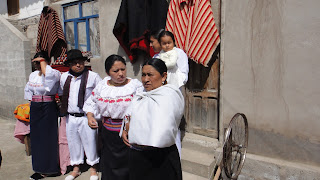After our first night in Otavalo, we headed out to the city early in the
morning and hit the local markets, led by one of the dancers from last night’s
performance. Some stores were outdoors selling all sorts of fruits and
vegetables, including localities, but the biggest set of markets were under an
expansive roof. The space was shared among fish, meat, vegetable, and spice
sellers. When we left these markets we continued through the Otavalo streets
and eventually arrived at the home of the dancer, whose family’s specialty is
making ponchos. They welcomed us graciously and were happy to teach us the
process of making a poncho. Here is a quick summary:
First, the wool is pulled and softened by hand so that it can be ready to spin. It
is then attached to a spinning machine and rolled and pulled by hand until it
is tightened into the yarn we see in stores. Then it is tied into a bunch so that it can be prepared for
dying. There are all sorts of colors available, including red, blue, and green.
When the yarn is dyed, it is spun over a cone-shaped instrument so that it can
be gathered into a spool. The next step is to take two of these spools and once
again using the spinning machine twist them together to create a stronger,
thicker yarn. This is the yarn that is used to make the poncho on special
weaving machines. The students got to try a few steps of this process,
including weaving, which was done on a machine over 500 years old!
After this extensive tour, the family was kind enough to give us each a
woven scarf. They also treated us to a local juice, which was homemade. One of
the members then lead us not far from the home to an open green space in the middle of the city, which had a
river, lots of plants and llamas as well as goats roaming around. The place was
previously a garbage dump, but the family bought it, cleaned it up, and planted
grass and flowers. It was a really beautiful piece of land. After this we said
a final goodbye and headed back to the hotel for lunch.











































No comments:
Post a Comment